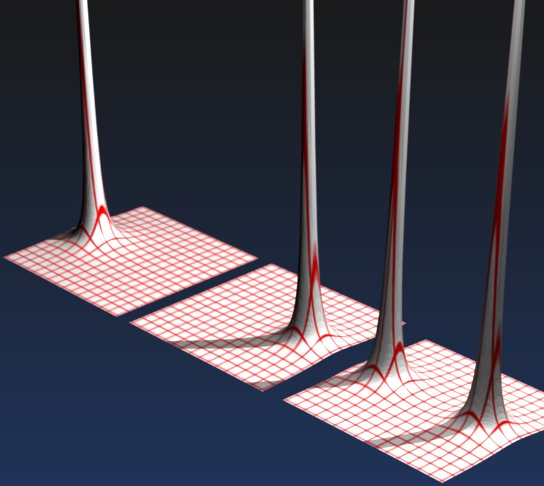Grad is short for gradient, it takes a scalar field as input and returns a vector field, for a 3 dimensional vector field it is defined as follows:
| grad(s) = i | ∂s | + j | ∂s | + k | ∂s |
| ∂x | ∂y | ∂z |
where,
- i,j and k are unit vectors representing the axis of the Cartesian coordinates.
- s is the scalar field, i.e. a scalar value which is a function of its position.
Or in more conventional vector notation:
| grad(s)= |
|
The vector returned has a direction which shows the greatest rate of change and its magnitude |v| tells us what that rate of change is. If you apply a grad to, say the height of a hill, you will get a vector pointing directly uphill, the length of which tells you how steep the hill is. Perhaps that may not be a good example as the height is normally the third dimension in a position vector but here we are separating it out as a scalar on a 2 dimensional map. Another example might be temperature, which is a scalar quantity, which might vary over 3 dimensions. grad of this temperature field would show where the temperature is changing most rapidly and would give the direction of heat flow.
If n is a normal to the contour lines then
| grad(s) = | ∂s | n |
| ∂n |
where:
n = normal vector
If the contour lines are closer together then grad(s) will be greater.
Vector Operator
The 'Del' operator represented by the 'Nabla' symbol![]() is used to represent the vector operator, as follows:
is used to represent the vector operator, as follows:
| ∂ | + j | ∂ | + k | ∂ | |
| ∂x | ∂y | ∂z |
or in more conventional vector notation:
|
The del symbol does not have any meaning on its own, only when applied to a scalar field. Or a vector field as shown later.
![]() s = grad(s)
s = grad(s)
Sum of Scalar Fields
Adding the scalar fields is equivalent to adding the grad functions:
grad(s1 + s2) = grad(s1) + grad(s2)
In the diagram below we have plotted the potential energy (scalar) field for:
- a single mass at x=-3
- a single mass at x=+3
- two masses at x=-3 and x=+3.

As we can see the field for the two masses is the sum of the other two fields.
Identities
sum of scalar fields:
grad(s1 + s2) = grad(s1) + grad(s2)
product of scalar fields:
grad(s1s2) = s1 * grad(s2) + s2 * grad(s1)
grad of dot product of vector fields:
grad(v1•v2) = (v2 •![]() ) v1 + (v1 •
) v1 + (v1 •![]() ) v2 + v2 × curl(v1) +v1 × curl(v2)
) v2 + v2 × curl(v1) +v1 × curl(v2)
where:
- grad() = grad function
- v1, v2 = vectors
 = del operator
= del operator - • = vector dot product
- × = vector cross product
- curl() = curl function

